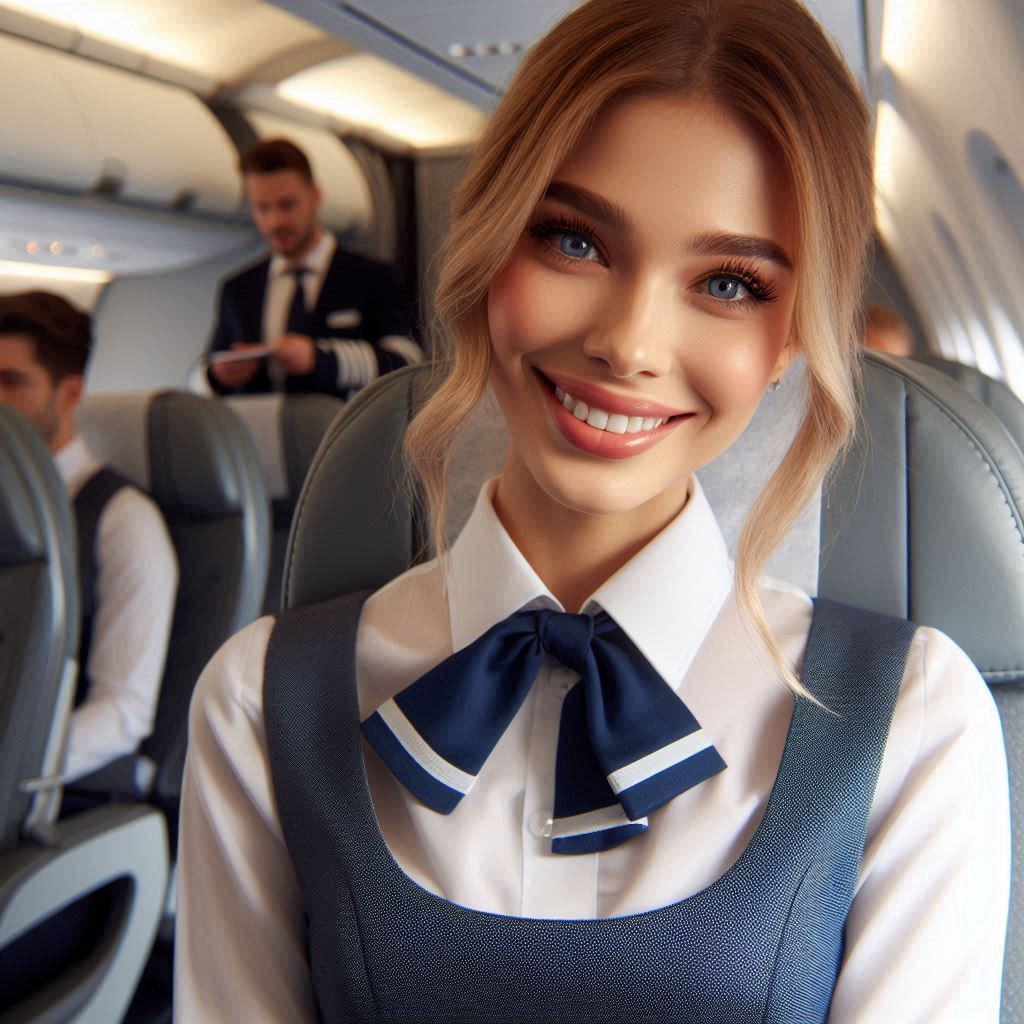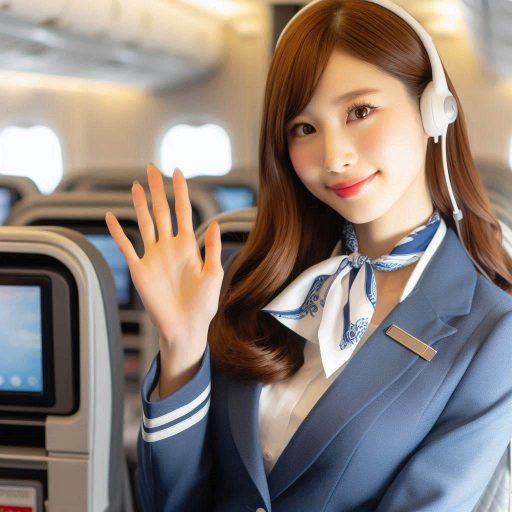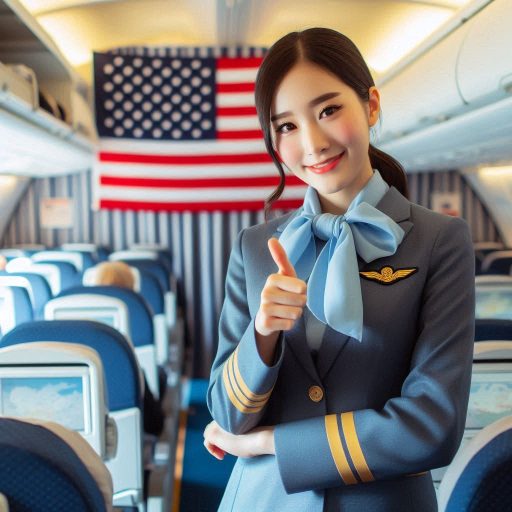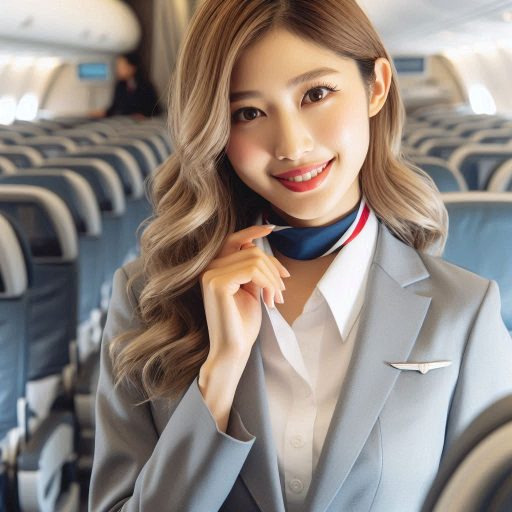Introduction
Technological advances have significantly transformed the flight attendant role in recent years.
The aviation industry continually evolves, driven by technological innovations.
These changes enhance safety, efficiency, and the overall passenger experience.
Technology plays a crucial role in modern aviation.
It streamlines operations, improves communication, and facilitates better service delivery.
Flight attendants now rely on various tools, from in-flight entertainment systems to advanced communication devices.
These tools help them respond promptly to passenger needs and ensure a smooth journey.
Advancements in technology have reshaped flight attendants’ responsibilities.
They now manage in-flight entertainment systems, troubleshoot technical issues, and utilize mobile devices for real-time information.
Flight attendants also engage with augmented reality applications to personalize passenger interactions.
Moreover, technology aids in training and preparation for emergencies.
Virtual reality simulations provide hands-on experience in a safe environment.
This training ensures flight attendants are well-equipped to handle any situation that arises.
Technological advances significantly impact the flight attendant role.
They enable more effective service and contribute to a safer and more enjoyable travel experience.
The aviation industry must continue to embrace these innovations to meet the demands of modern air travel.
Wearable Technology
Use of Wearable Devices Like Smartwatches or Smart Glasses by Flight Attendants
Wearable technology has transformed the role of flight attendants significantly.
Devices like smartwatches and smart glasses are becoming common tools in the aviation industry.
These devices enhance communication, improve efficiency, and promote safety during flights.
How These Devices Assist in Communication with the Crew and Passengers
Flight attendants use smartwatches to receive real-time updates from the cockpit.
They can access important information, such as flight status and passenger needs, instantly.
This immediate access allows them to respond quickly to any situation.
For instance, if there is a medical emergency, a flight attendant can notify the crew without delay.
Smart glasses also offer unique advantages.
They can display vital flight information and passenger requests directly in the attendant‘s line of sight.
This hands-free approach allows flight attendants to remain focused on their duties while accessing essential data.
They can monitor cabin conditions and respond to passengers efficiently.
Benefits of Wearable Technology in Enhancing Efficiency and Safety During Flights
Wearable technology significantly enhances safety during flights.
Flight attendants can receive alerts for potential issues, such as turbulence or equipment malfunctions.
This immediate information allows them to take preventive measures, ensuring passenger safety.
For example, if turbulence is imminent, attendants can secure the cabin before it begins.
These devices improve communication among crew members as well.
Flight attendants can connect with each other seamlessly, even across large aircraft.
Instant messaging features enable them to share information quickly.
This streamlined communication fosters teamwork and enhances the overall flying experience.
Additionally, wearable technology helps manage passenger interactions effectively.
Flight attendants can track passenger preferences and dietary restrictions through their devices.
This capability allows them to provide personalized service, enhancing customer satisfaction.
Happy passengers often lead to positive reviews and increased loyalty to the airline.
The benefits of wearable technology extend beyond communication.
These devices can also monitor flight attendants’ health and well-being.
For instance, smartwatches can track physical activity and remind attendants to stay hydrated.
This focus on health encourages flight attendants to prioritize their wellness during long shifts.
Wearable technology significantly impacts the role of flight attendants.
Smartwatches and smart glasses enhance communication, improve efficiency, and promote safety.
By adopting these devices, flight attendants can perform their duties more effectively.
This technological shift not only benefits flight attendants but also enhances the overall passenger experience.
The aviation industry continues to evolve, and wearable technology plays a vital role in this transformation.
Embracing these advancements ensures flight attendants remain at the forefront of excellent service and safety in the skies.
Read: Nail Technician Networking: Building Industry Connections
In-Flight Entertainment Systems
The Troubleshooting In-Flight Entertainment Systems
In-flight entertainment systems play a vital role in enhancing the passenger experience.
Flight attendants are essential in operating and troubleshooting these systems.
They ensure that passengers have access to various entertainment options, such as movies, music, and games.
Flight attendants perform routine checks on entertainment systems before flights.
They familiarize themselves with the technology on board.
This preparation helps them respond effectively to any technical issues that arise during the flight.
When passengers encounter problems, flight attendants quickly troubleshoot the systems.
They assist passengers in using remote controls and navigating menus.
Their ability to resolve issues promptly enhances passenger satisfaction.
How Advancements in Entertainment Technology Have Improved the Passenger Experience
Advancements in entertainment technology have significantly improved the passenger experience.
Modern systems offer a wider variety of content, including the latest movies and TV shows.
Passengers can stream content directly to their personal devices, increasing convenience.
Many airlines now provide Wi-Fi access, allowing passengers to browse the internet during the flight.
Interactive features, such as games and flight information displays, keep passengers engaged.
These improvements help reduce perceived flight duration, making the journey more enjoyable.
Enhanced audio and video quality also contribute to a superior in-flight experience.
How Flight Attendants Are Trained to Assist Passengers with Various Entertainment Options
Flight attendants undergo extensive training to assist passengers with entertainment options.
They learn how to operate the entertainment systems effectively.
This training includes troubleshooting common issues that passengers may encounter.
Flight attendants also receive updates on new technologies and features introduced by the airline.
Understanding the entertainment content available is equally important.
Flight attendants can recommend movies, shows, or music based on passengers‘ preferences.
This personalized approach enhances the overall flight experience.
Additionally, flight attendants help passengers connect their devices to the in-flight entertainment system.
They guide passengers through the setup process, ensuring a smooth connection.
Their ability to assist passengers fosters a positive atmosphere in the cabin.
Flight attendants play a crucial role in managing in-flight entertainment systems.
They operate and troubleshoot these systems to ensure a seamless experience for passengers.
Advancements in entertainment technology have transformed the passenger experience, offering more options and improved quality.
With thorough training, flight attendants are well-equipped to assist passengers with various entertainment options.
Their expertise contributes significantly to passenger satisfaction during flights.
By providing exceptional service, flight attendants help create memorable travel experiences.
In-flight entertainment systems continue to evolve, and flight attendants remain at the forefront of these changes.
Read: The Role of Technology in Modern Pet Grooming
Communication Tools
Use of Advanced Communication Tools Like Tablets or Smartphones by Flight Attendants
Advanced communication tools have revolutionized how flight attendants operate during flights.
Tablets and smartphones have become essential devices for flight crews.
These tools allow flight attendants to access important information quickly.
They use these devices to check passenger lists, meal orders, and special requests in real-time.
With mobile devices, flight attendants can communicate efficiently among themselves.
They can quickly share updates regarding passenger needs and any changes during the flight.
This instant access to information streamlines cabin operations, ensuring a smooth flight experience.
How These Tools Help in Relaying Important Information to the Crew and Ground Staff
Communication tools enhance the flow of information between flight attendants and the crew.
Flight attendants relay important updates, such as passenger health issues or safety concerns.
They can send messages directly to the cockpit, ensuring that pilots are aware of any significant developments.
Additionally, these tools enable flight attendants to communicate with ground staff during flights.
They can report on flight status, delays, and any special requests from passengers.
This connection helps ground staff prepare for the aircraft’s arrival.
Passengers benefit from this improved communication as it ensures timely service and assistance.
Impact of Improved Communication Technology on Emergency Situations During Flights
Improved communication technology has a significant impact on emergency situations.
During a crisis, every second counts, and timely communication is vital.
Flight attendants can use their devices to quickly inform the cockpit of any emergencies.
This immediate notification allows pilots to take appropriate actions without delay.
In emergencies, flight attendants can also communicate directly with medical personnel on the ground.
They can relay vital information about passenger health issues, allowing for faster medical response upon landing.
Furthermore, enhanced communication tools enable flight attendants to coordinate with each other effectively during emergencies.
They can quickly share responsibilities and information, ensuring that all passengers receive appropriate assistance.
This coordinated approach increases passenger safety and comfort during critical situations.
Advanced communication tools like tablets and smartphones have transformed flight attendant operations.
These devices facilitate efficient communication among crew members and ground staff.
They enhance the relaying of important information, ensuring smooth cabin operations.
In emergency situations, improved communication technology significantly impacts safety and response time.
Flight attendants can swiftly inform the cockpit and coordinate efforts among the crew.
Their ability to communicate effectively ensures passenger safety and contributes to a positive flying experience.
As technology continues to evolve, flight attendants will remain essential in leveraging these tools for better service and safety.
Read: Customer Service Tips for Pet Grooming Professionals

Cabin Crew Management Software
Concept of Cabin Crew Management Software Used by Airlines
Cabin crew management software is essential for modern airlines.
This technology helps airlines manage their flight attendants efficiently.
It simplifies scheduling, training, and communication among crew members.
Airlines rely on this software to optimize operations and improve service quality.
Features of Such Software That Aid Flight Attendants in Their Daily Tasks
Cabin crew management software includes several features that support flight attendants.
First, it provides real-time scheduling updates, allowing crew members to view their shifts easily.
Flight attendants can access their rosters from any device, enhancing flexibility.
The software also includes a training module.
Flight attendants can track their training progress and complete mandatory courses online.
This feature ensures that all crew members remain compliant with safety regulations.
Additionally, the software often includes a messaging system.
Flight attendants can communicate directly with each other and management.
This immediate communication streamlines information sharing and enhances teamwork.
Another critical feature is the ability to manage passenger data.
Flight attendants can access vital information about passengers, such as special requests or needs.
This access allows them to provide personalized service during flights.
How This Technology Streamlines Operations and Enhances Coordination Among the Crew
Cabin crew management software streamlines airline operations significantly.
By automating scheduling, airlines reduce the risk of errors.
This automation ensures that flights are adequately staffed and that all crew members are informed of their responsibilities.
The software also enhances coordination among crew members.
With real-time updates, all flight attendants stay informed about changes to schedules or assignments.
This coordination fosters a more efficient working environment, ultimately benefiting passengers.
In addition, the software improves communication with ground staff.
Flight attendants can relay any special requests or issues that arise during the flight.
This effective communication ensures that ground teams are prepared for the aircraft’s arrival.
Moreover, data analytics features in the software allow airlines to monitor crew performance.
Airlines can identify trends, such as frequent delays or issues, and address them proactively.
This analysis helps improve overall efficiency and enhances service quality.
Cabin crew management software is vital for modern airlines.
It aids flight attendants in their daily tasks by providing scheduling, training, and communication tools.
This technology streamlines operations and enhances coordination among crew members.
By automating processes and improving information sharing, airlines can operate more efficiently.
This efficiency ultimately leads to better passenger experiences.
As the aviation industry continues to evolve, cabin crew management software will play a crucial role in optimizing operations and improving service delivery.
Read: Nail Technician Etiquette: Dos and Don‘ts
Find Out More: How Real Estate Agents Utilize CRM Systems
Virtual Reality Training
Role of Virtual Reality in Training Flight Attendants for Various Scenarios
Virtual reality (VR) plays a transformative role in training flight attendants.
This technology immerses trainees in realistic environments that mimic actual flight scenarios.
By using VR, flight attendants can experience their job duties in a controlled, safe setting.
This training method helps them build confidence and competence before they work with passengers.
VR training covers various scenarios, from routine tasks to emergency situations.
It allows flight attendants to engage in lifelike simulations that replicate real-life challenges.
This immersive experience prepares them for the unexpected situations they may encounter during flights.
How Virtual Reality Simulations Help in Practicing Emergency Procedures and Customer Service Skills
Virtual reality simulations are crucial for practicing emergency procedures.
Trainees can rehearse evacuation drills, fire responses, and medical emergencies in a safe environment.
This practice builds muscle memory and enhances their readiness to act swiftly in actual emergencies.
In addition to emergency procedures, VR training focuses on customer service skills.
Flight attendants can interact with virtual passengers, handling diverse scenarios that test their communication and problem-solving abilities.
This interaction helps them refine their customer service techniques and adapt to various passenger needs.
The feedback provided by VR systems is immediate and constructive.
Trainees receive real-time evaluations on their performance, allowing them to identify areas for improvement.
This immediate feedback helps them adjust their approach, fostering continuous growth and development.
Transform Your Career Today
Unlock a personalized career strategy that drives real results. Get tailored advice and a roadmap designed just for you.
Start NowBenefits of Virtual Reality Training in Providing Hands-On Experience in a Safe Environment
Virtual reality training offers several benefits for flight attendants.
First, it provides hands-on experience without the risks associated with real-life training.
Trainees can make mistakes in a virtual environment without jeopardizing safety.
Second, VR training enhances engagement and retention.
The immersive nature of VR keeps trainees focused and motivated.
They are more likely to remember their training experiences and apply what they learned in real situations.
Moreover, VR training is highly adaptable.
Airlines can customize scenarios to reflect their specific procedures and protocols.
This customization ensures that training aligns with company policies and standards.
Finally, VR training reduces costs associated with traditional training methods.
Airlines can save on travel expenses and time by utilizing VR technology.
This efficiency allows them to train more employees simultaneously, enhancing overall workforce readiness.
Virtual reality training significantly improves the preparation of flight attendants.
It immerses them in realistic scenarios, enhancing their confidence and skills.
By practicing emergency procedures and customer service skills, flight attendants become better prepared for their roles.
The hands-on experience in a safe environment fosters skill development and enhances safety.
As technology continues to advance, VR training will likely become a standard practice in the aviation industry.
This evolution will further enhance the quality of flight attendant training programs and improve passenger experiences.
Augmented Reality for Passenger Service
How Augmented Reality Technology Is Utilized by Flight Attendants to Enhance Passenger Service
Augmented reality (AR) technology enhances passenger service in aviation significantly.
Flight attendants use AR tools to provide real-time information and assistance.
These tools overlay digital content onto the physical world, improving the travel experience for passengers.
AR applications enable flight attendants to quickly access important information.
For example, they can view flight details, passenger preferences, and service requests instantly.
This access helps flight attendants deliver timely and efficient service throughout the flight.
Additionally, AR technology allows flight attendants to showcase in-flight amenities visually.
They can project menus, entertainment options, and safety information directly to passengers.
This interactive approach keeps passengers informed and engaged during the flight.
Use of AR Apps for Personalized Passenger Interactions and Language Translations
AR apps facilitate personalized interactions between flight attendants and passengers.
These apps can provide information about individual passengers, such as dietary restrictions and special requests.
Flight attendants can use this information to tailor their service, enhancing the overall experience.
Language barriers can create challenges during flights.
AR technology helps mitigate these issues through translation features.
Flight attendants can use AR apps to translate information into a passenger’s preferred language instantly.
This capability ensures clear communication and improves the passenger experience.
Furthermore, AR apps can guide passengers through the cabin.
Flight attendants can point out nearby facilities, such as restrooms and exits, using AR markers.
This guidance enhances passenger comfort and safety during their journey.
Positive Impact of Augmented Reality on Customer Satisfaction and Overall Flight Experiences
The positive impact of augmented reality on customer satisfaction is significant.
Passengers appreciate the personalized service AR technology provides.
They feel valued when flight attendants cater to their specific needs and preferences.
Enhanced communication through AR tools leads to fewer misunderstandings.
Passengers are more likely to receive the assistance they require promptly.
This improved interaction fosters a sense of trust and comfort during the flight.
Moreover, AR technology elevates overall flight experiences.
Passengers enjoy engaging with the innovative features that AR offers.
These features create a modern and memorable travel experience, setting airlines apart from competitors.
Airlines that implement augmented reality technologies demonstrate their commitment to passenger satisfaction.
By investing in AR, they enhance service quality and build stronger relationships with their customers.
Augmented reality technology transforms passenger service in aviation.
Flight attendants leverage AR tools to provide personalized interactions and efficient communication.
This technology significantly impacts customer satisfaction and overall flight experiences.
As the aviation industry embraces digital advancements, AR will likely play an even larger role.
By enhancing passenger service, airlines can create memorable journeys and foster customer loyalty.
The future of air travel will increasingly rely on innovative technologies like augmented reality to enhance passenger experiences.
Conclusion
Technological advances significantly enhance the flight attendant role.
Wearable technology, in-flight entertainment systems, and communication tools streamline operations.
Virtual reality and augmented reality training provide realistic experiences, improving skills and passenger interactions.
Embracing technology is vital for the future of the aviation industry.
It increases efficiency, safety, and customer satisfaction.
Airlines that adopt these innovations gain a competitive edge and enhance overall flight experiences.
Continued innovation and adaptation are essential in the field of inflight services.
Technology evolves rapidly, and flight attendants must stay current.
Training programs should incorporate the latest tools and techniques to prepare staff effectively.
Moreover, fostering a culture of innovation encourages flight attendants to embrace new technologies.
They can provide better service and respond to passenger needs promptly.
In summary, technology transforms the flight attendant role and improves the entire travel experience.
Airlines must prioritize investment in technology to meet the demands of modern air travel.
By doing so, they will create safer, more efficient, and enjoyable flights for everyone.
The aviation industry stands at the forefront of technological advancements.
Embracing these changes will lead to a brighter future for flight attendants and passengers alike.
[E-Books for Sale]
The Big Book of 500 High-Paying Jobs in America: Unlock Your Earning Potential
$19.99 • 500 High-Paying Jobs • 330 pages
Explore 500 high-paying jobs in America and learn how to boost your career, earn more, and achieve success!
See All 500 High-Paying Jobs of this E-Book
1001 Professions Without a Degree: High-Paying American Jobs You Can Start Now
$19.99 • 1001 Professions Without a Degree • 174 pages
Discover 1001 high-paying jobs without a degree! Unlock career tips, skills, and success strategies for just $19.99!




